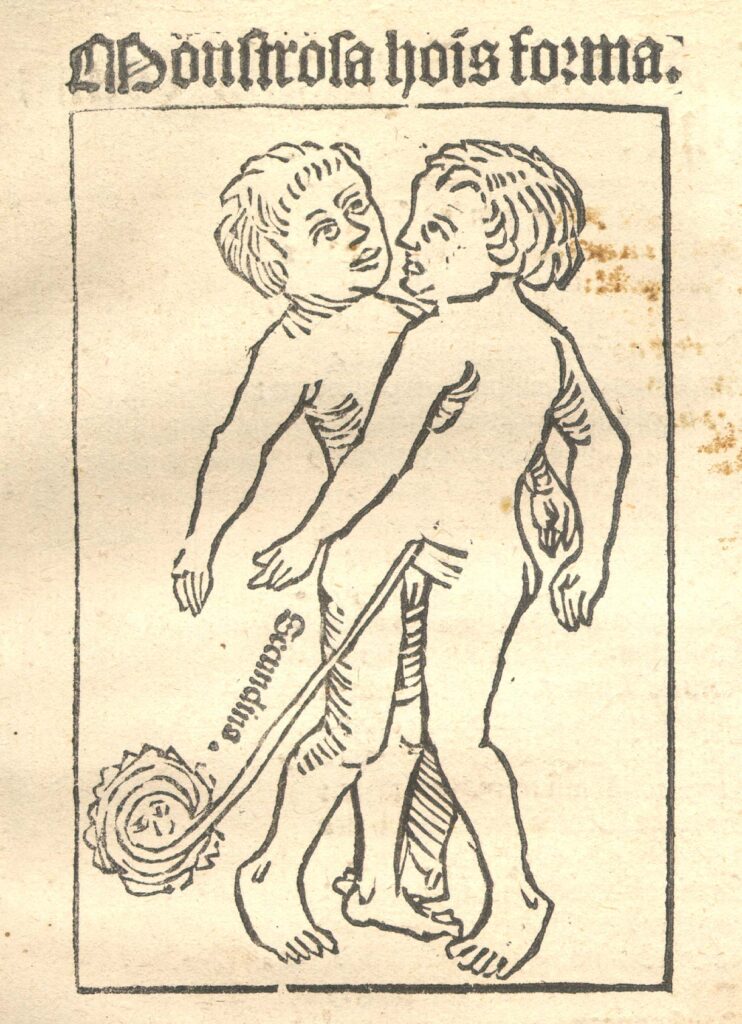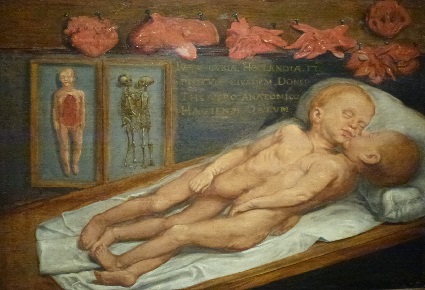Catholic doctrine holds that the soul is the animating principle of the body. Following Aristotle, most Catholic thinkers traditionally considered the soul to be the “form of the body,” that is, the actuating principle of life which gives a being its capacity for self-sustenance, growth, and reproduction. The human soul is unique in that it is rational and immortal, accounting for man’s unique and privleged place in the hierarchy of being. Every individual is “ensouled” by an act of God at the moment of their creation.
The traditional understanding of the soul thus drew on concepts both theological and philosophical to explain the unity of man’s spiritual nature with his material body. This concept was challenged, however, by the existence of conjoined twins—siblings born stuck together. As conjoined twins appeared to be both one and yet distinct, it was debated whether their soul was singular or dual. Were conjoined twins to be regarded as two beings with two souls, or one being in possession of a single soul? This question was no abstraction; if the soul is the form of the body, then personhood is directly contingent upon the presence (or absence) of a soul. The question was thus pragmatic—should conjoined twins be regarded as one person or two, legally, socially, and canonically?

The Ballestero Twins
The first autopsy ever recorded in the New World was carried out to resolve this very question. In 1533 within the Spanish colony of Hispaniola, Melchiora Ballestero, the wife of Joan Lopez Ballestero, gave birth to a pair of conjoined twins. Such births were considered “monsters” or “monstrosities,” a term derived from the Latin monstrare, “to look at,” denoting that the occasion was a spectacle, something worth seeing. A “monstrosity” was thus not a term implying something horrid or gruesome so much as an object of curiosity. Monstrosities were generally considered worthy of recording because of their rarity. Accordingly, the Bellestero monstrosity was recorded in the 1535 General and Natural History of the Indies by the Conquistador Fernández de Oviedo, the royally designated historian of the Indies. Oviedo reported:
In this city of Santo Domingo in the island of Hispaniola on Thursday
night, July 10, 1533; Melchiora, wife of Joan Lopez Ballestero, both natural [natives] of Seville but now residing in this city, delivered two daughters attached to each other in the manner that I shall describe later. On the following day, myself and a number of witnesses that included members of the justice and the church, as well as many neighbors, strangers, and other people that were staying in the city visited the home of Joan. The mother was in bed and in the presence of her husband, the children were unwrapped and once naked I saw that they were attached at the level of the umbilicus to just below the nipples. They were united from the umbilicus to the stomach or a little bit higher, but the breasts and nipples and everything else above these structures were separate. Each child had two arms, one neck and a well shaped and attractive head. They were completely separated from the umbilicus down and were joined not facing each other but rather at an angle. On being unwrapped, both began to cry, and later when covered again one stopped crying but the other continued for a spell. (1)
The girls were given the names Joana and Melchiora, after their parents. Shortly after birth, Joan had them baptized by the local priest. Here is where the trouble began. Oviedo records that:
The priest stated that he baptized both separately as a matter of precaution since he was not sure whether they actually represented two bodies and two souls or only one. (2)
After the ritual the priest insisted on a stipend for the baptism, as was custom. As he had baptized each of the children separately, he asked for two payments rather than one. The father, already “unhappy to have sired a monster,” refused to pay for two baptisms, protesting that as the twins were a single body, they must possess a single soul. Ergo a single baptism—and stipend—was sufficient. (3)
One Soul or Two? The Autopsy of the Ballestero Twins

In the midst of the wrangling about payment, the twins died eight days after birth. The authorities, both lay and ecclesiastical, saw the tragedy as an opportunity to learn about the biology of conjoined twins. They asked permission to perform an autopsy to determine, if possible, whether the little Melchiora and Joana in fact shared a single soul.
Modern Catholic sensibility may scoff at such a proposition. After all, the soul is entirely immaterial; it cannot be found by looking inside a person’s body. While the soul’s immateriality was understood, theologians nevertheless believed that the soul had some connection to the body, positing that various bodily organs were the “seat” of the soul. The most common belief in the 16th century was that the liver was the “seat” of the soul, a theory posited by the ancient philosophy of Empedocles and widely believed in the Renaissance. This theory was known as hepatocentism. (4) The hepatocentric theory did not assert the soul to be “in” the liver in any material sense. Rather, the liver was viewed as the occasion of the soul, the locus of the soul’s action on the body. If, therefore, an autopsy revealed that the twins shared a single set of organs—especially a liver—it would be considered likely that they also shared a single soul. But if they were found to possess dual sets of organs, it could be posited that they also possessed dual souls.
Oviedo continues:
The parents consented to have them cut open. Placed on a table; Joan Camacho who held a Bachelor’s Degree and was an excellent surgeon made an incision with a knife in the presence of two doctors of medicine: Hernando de Sepulveda and Rodrigo Navarro. The incision was made through the umbilicus and both bodies were eviscerated. They had the full complement of entrails to be found in two human bodies, to wit: two stomachs with their corresponding separate intestines and two kidneys, two lungs and one heart in each set of viscera. The livers were not separate but fused to each other, however, there was a groove that outlined the part of the fused livers that belonged to each body. There were two gallbladders. When opened, the umbilicus or vine, that externally appeared single, internally was divided into two vines, one for each body. When asked if the creatures while alive showed any differences in feeding habits or other activities, the father answered that sometimes one cried while the other was silent. This I observed the first time I saw them and so did the other witnessess. He added that at times one was asleep while the other was awake, and that while one defecated or urinated the other did none of the above. However, occasionally they will do these functions simultaneously, at times one would anticipate the other. (5)
You will notice Oviedo’s care to note that there were two livers, but fused together. He also includes details about dual gallbladders. These specifics were likely noted with reference to the hepatocentric theory of Empedocles, mentioned above. (6) The doctors seemed unsure what to make of the liver, as there were clearly two organs but fused together. This necessitated the secondary questions on the twins’ bodily functions were asked in hopes of clarifying whether they lived as one or two. That the twins ate, slept, cried, and defecated separately clinched the argument that they were possessed of two souls, not one. Hence Oviedo reports the conclusion of the doctors:
This will prove, even without having them cut open, that they were two separate persons and two souls. Thus Joana and Melchiora left this world for the Celestial Glory where it pleases our Lord that we should see them. (7)
We are not told the outcome of Joan’s dispute with the priest, but presumably the stingy father was compelled to pay for two baptismal stipends.
Conclusion
The Ballestero autopsy is an interesting event where the history of the New World, of science, and of Catholic theology all overlapped. It demonstrates the attempts of Catholic thinkers to understand biological oddities in light of Catholic anthropology and man’s spiritual nature. After the Ballestero autopsy, theologians increasingly treated conjoined twins as two separate individuals, such that the Bellestero case came to be viewed as a kind of precedent for related situations in the future.
(1) De Oviedo, F.: Historia General y Natural de las Indias. Madrid, Biblioteca de Autores Espaholes, 1959, tome CXVII, vol. 1, chap. 11, pp. 170-72.
(2) Ibid.
(3) Jimenez, Fidelio A. “The First Autopsy in the New World,” Bulletin of the New York Academy of Medicine, Vol. 54, No. 6, June 1978, pp. 618- 619. Available online at: https://www.ncbi.nlm.nih.gov/pmc/articles/PMC1807498/pdf/bullnyacadmed00131-0078.pdf
(4) “I Miss My Liver: Nonmedical Sources in the History of Hepatocentrism,” Hepatology Communications, Aug. 2018; Vol. 2(8): 982–989.
(5) Oviedo, 172
(6) Jimenez, 619
(7) Oviedo, 172
Phillip Campbell, “The Ballestero Case: The Problem of the Soul in Conjoined Twins,” Unam Sanctam Catholicam, July 11, 2023. Available online at: https://unamsanctamcatholicam.com/2023/07/the-ballestero-case-the-problem-of-the-soul-in-conjoined-twins

